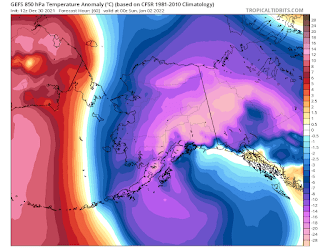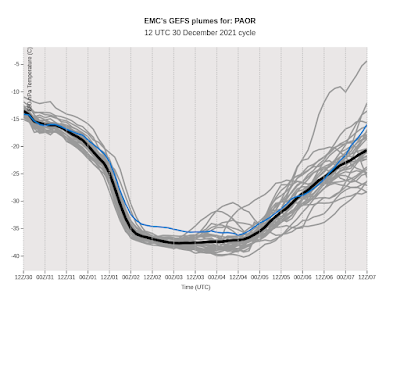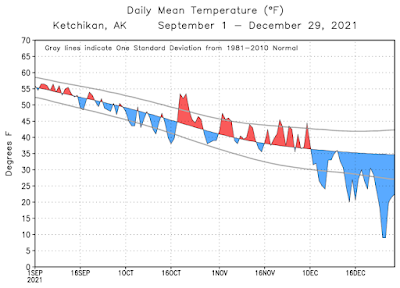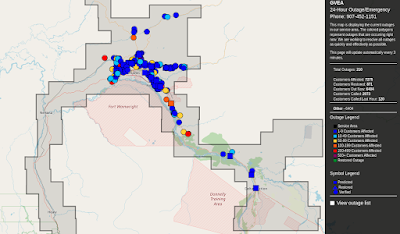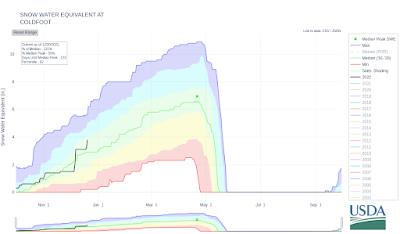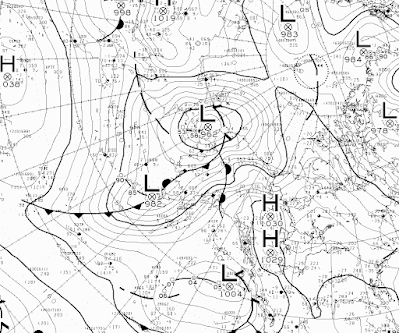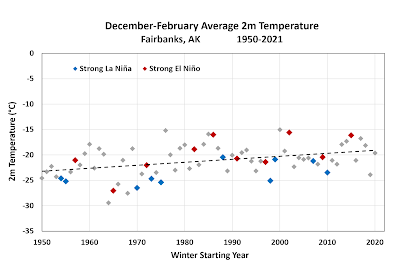Objective Comments and Analysis - All Science, No Politics
Primary Author Richard James
2010-2013 Author Rick Thoman
Thursday, December 30, 2021
How Cold Will It Get?
Wednesday, December 29, 2021
More Wild Weather
Another day, another climate headline: 2021 is now the wettest year on record in Fairbanks. Rick Thoman illustrates the remarkable increase since 2013:
Fairbanks has set a new record for annual precipitation (rain plus melted snow). As of 9am Wednesday the 2021 total up to 18.62" (472.9mm). The previous record was 18.52" in 1990. A sustained & dramatic precip increase past 8 years #akwx @Climatologist49 @newsminer @IARC_Alaska pic.twitter.com/FTogDd4yEV
— Rick Thoman (@AlaskaWx) December 29, 2021
A leading hypothesis for explaining the change has to be the sustained tendency for North Pacific high pressure, which is linked to unusual sea surface warmth (recall the so-called "blob" of warmth dating back to winter 2013-2014). As discussed in recent days, an intense North Pacific ridge is to blame for the current onslaught of wild weather; here's a nice animation courtesy of Stu Ostro at the Weather Channel:
That #ridge pic.twitter.com/e03evpN5wI
— Stu Ostro (@StuOstro) December 29, 2021
Last night's winter storm in Fairbanks ended with a remarkable and extremely unusual snow squall this morning: heavy snow, near-zero visibility, and winds gusting to 45 mph.
Localized blizzard conditions are occurring in the Fairbanks area as this band of heavy snow moves through along with gusty winds. Visibility will be reduced to a 1/4 mile or less at times. #AKwx pic.twitter.com/MCv0TFBMPi
— NWS Fairbanks (@NWSFairbanks) December 29, 2021
For posterity, here's the airport METAR at the height of the squall:
PAFA 291653Z 28024G39KT 1/4SM R02L/1200V2600FT +SN BLSN FG VV004 M01/M03 A2956 RMK AO2 PK WND 28039/1645 SLP020 P0003 T10061033 $
Heavy wind-driven snow like this is virtually unheard-of in Fairbanks, and I found only a tiny number of past cases when conditions may have been similar. In fact there are zero previous observations with a combination of moderate or heavy snow, visibility of 1/4 mile or less, and sustained winds of 20 knots or greater; but Rick pointed out that in earlier decades the observer may have just reported "blowing snow". Even then, the only dates that may have been similar are the following:
March 28, 1948
Dec 28, 1951
March 10, 1963
Feb 26, 2011
Here's one of Rick's comments in the aftermath of the 2011 event: "February 2011 will be long remembered in the annals of Fairbanks weather lore, with back to back storms that are close to "blizzards" as Fairbanks ever gets (which is to say, not that close)."
https://ak-wx.blogspot.com/2011/03/february.html
Tuesday, December 28, 2021
Storm Follow-Up
Monday, December 27, 2021
Power Outages
Big problems loom for Fairbanks-area homes and businesses that continue without power into tonight, as temperatures drop off to levels that will produce damage in unheated structures. As of 1pm, GVEA is reporting more than 6000 customers without electricity; hopefully many of these have robust supplemental heat sources for just such on occasion as this.
Temperatures are down to around 20°F as the winds have died down under partly clear skies, and the NWS is going for a low temperature of 10°F tonight. The next round of cloud and snow will prevent a bigger drop for now - the real cold comes later in the week.
As reader Gary noted, above-freezing temperatures beginning yesterday afternoon did help prevent even greater damage to infrastructure, as accumulated snow and ice was melting quickly by the time winds picked up in the evening. Wind without a thaw would have been even worse.
Last night's high temperature of 41°F was the first 40+ temperature in winter for over 4 years in Fairbanks, but this was no chinook flow from the south; the wind was more or less westerly through the entire depth of the troposphere:
Historic Winter Rain
Saturday, December 25, 2021
Big Interior Storm
Historic rain/freezing rain event looks increasingly likely for parts of Alaska starting Sat night with deep moisture direct from Kauai. Bad impacts of rain in mid-winter can't be overstated. Nerd alert: IVT levels would be notable in August! #akwx @Climatologist49 @LukeCulverWx pic.twitter.com/oVQnr6m1eL
— Rick Thoman (@AlaskaWx) December 24, 2021
Significant rain in Fairbanks in winter (Dec-Feb) is very rare but it has occurred. Only thrice in the past century has there been a storm (this time of year) that produced more than 0.40 inches of rain. Next few days may bring another. #akwx #winter @Climatologist49 @Anisian pic.twitter.com/YZfKno7kO1
— Rick Thoman (@AlaskaWx) December 24, 2021
Thursday, December 23, 2021
Monday's Warmth
Monday, December 20, 2021
Wiseman Snow Follow-Up
Last week's post mentioned the remarkable 41" snowfall at Wiseman a couple of weeks ago, and I remarked that the limited historical data suggest this location is prone to occasional very large snow events. Here's some follow-up based on a slightly closer look.
First, it's interesting to note that the average seasonal snowfall totals are not particularly high at Wiseman. Based on a common set of 13 winters since 1996 that have reasonably complete data at Wiseman, Bettles, and Fairbanks, the median seasonal snow totals indicate that Bettles is considerably snowier overall:
Bettles 97"
Wiseman 72"
Fairbanks 57"
Despite this, Wiseman reported daily snow amounts of 12" or more on 10 different days during these winters, whereas Bettles had only one such day, and Fairbanks had none! (But a few days came close in both Bettles and Fairbanks.)
Here's a simple chart showing the frequency of days with snow totals in several categories, again based on a common set of 13 winters.
One possible explanation for the large excess of big snows at Wiseman would be that the observer(s) may have tended to report storm totals as single-day snow amounts on the final day of a multi-day event. However, some of the big single-day totals also have large snow amounts on adjacent days, leading to extreme storm totals, such as:
40.5" Jan 23-24, 1999 (the two-day record until the most recent event)
47.5" Jan 22-24, 2000
29.6" Feb 12-13, 2019
Given what happened two weeks ago, with independent corroboration from the Coldfoot road crew, there's no doubt these events can happen. It's just surprising that they don't show up in terms of high seasonal averages; but perhaps that could be explained by the observer failing to report many small events that would add up significantly over the course of a long winter.
For reference, here's the location of Wiseman; it certainly makes sense that orographic lifting would squeeze a lot of moisture out of flow that comes up from the southwest.
By way of comparison, the SNOTEL sites at Bettles and Coldfoot show similar snowpack statistics, with median water-equivalent snowpack peaking between 6" and 7" in late winter. It's a little difficult to imagine that Wiseman would be much different, only 10 miles north of Coldfoot.
Speaking of heavy winter precipitation, Fairbanks just saw over an inch of liquid-equivalent in 24 hours, as another round of extremely warm and moist air enveloped a large part of the state. I'll hopefully be able to post more comments on this soon.
Fairbanks Airport total precipitation (here melted snow) between 9am Sunday & 9am Monday was 1.21" (30.7mm). Not only more than twice normal for the entire month, also only second time past 92 years with more than 1" precip in Dec in 24 hours. #akwx @Climatologist49 @newsminer pic.twitter.com/t249m0ilRW
— Rick Thoman (@AlaskaWx) December 20, 2021
These high temperatures may not seem mild, but for areas north and west of Fairbanks, which are largely outside of the climatological "chinook zone", these are exceptionally mild for mid-winter. #akwx @Climatologist49 pic.twitter.com/9RpAxu5Xgk
— Rick Thoman (@AlaskaWx) December 20, 2021
Saturday, December 11, 2021
Weather Notes and November Data
It's been an active week for Alaska weather in the wake of the big warm-up, with a fast-moving storm raking the lower Alaska Peninsula on Thursday, followed by cold air rushing back into the western part of the state as the ridge rebuilds over the Bering Sea. Wind chills along the west coast today are some of the lowest so far this winter.
Cold Bay saw hurricane-force wind gusts on Thursday, and sustained winds exceeded 50 knots (57 mph); this only happens about once every other winter on average.
Deep, fast moving storm in Bristol Bay is lashing the lower Alaska Peninsula with strong winds Thursday morning. Multiple communities with near or above hurricane force gusts. #akwx @Climatologist49 @kdlgradio @KUCBNews pic.twitter.com/oAJNNMWQPT
— Rick Thoman (@AlaskaWx) December 9, 2021
More significantly - from a statistical standpoint - was the remarkably intense snowfall that occurred earlier in the week on the southern foothills of the Brooks Range: the Wiseman co-operative observer reported over 41" of snow in two days. This is an all-time record for two-day snowfall in the Wiseman period of record, which includes about 30 winters of reasonably complete snowfall data.
The previous two-day record was 40.5" in January 1999, but 30" has been exceeded four times before this week - and February 2019 came very close (29.6"). For comparison, the all-time maximum two-day snowfall in other interior locations are as follows:
Bettles 25.0"
Fairbanks 26.9"
McGrath 21.0"
Amazingly, the Wiseman snow amounted to only 1.09" of liquid equivalent, so that's a 38:1 snow:liquid ratio. Here's what it looked like on the nearby Dalton Highway:
Hello #snow! Check out this photo from the Dalton Hwy earlier this week. Our Coldfoot crew reported 30 inches even though the rest of the road didn't get much snow at all. It's a reminder to ALWAYS be prepared for winter conditions this time of year. Safe travels! 📷 Jason Carson pic.twitter.com/wxikiLv9ob
— Alaska DOT&PF (@AlaskaDOTPF) December 8, 2021
The incredible snowfall appears to have been a consequence of the deep southerly flow that prevailed for some days to the east of the near-record Bering Sea storm. Lots of moisture was transported up from the south, the Brooks Range topography created orographic lift, and evidently there must have been some west-east convergence to set up a near-stationary band of heavy snow. One wonders how much fell on the higher terrain just to the north.
On another topic, below are the November NCEI and ERA5 rank maps to follow up on my earlier comments. In addition to being extremely cold in the west and southwest, those areas were also generally much drier than normal, much less windy than normal, and much sunnier than normal (for what that's worth at this season).
Tuesday, December 7, 2021
How to Eliminate Cold
The reprieve won't last long, but a very powerful Bering Sea storm has dramatically swept away the cold air that dominated the state in the past few weeks. It was an extraordinary transformation: check out the sequence of daily temperature maps below, showing Friday through yesterday.
Rick Thoman notes the extraordinarily rapid change in the statewide daily temperature index:
How fast did the weather change over Alaska? The Alaska Statewide Temperature Index, one of our ACCAP tools, showed its largest one day change (Saturday to Sunday) in over a decade. Details about the index at https://t.co/eph70nSIeM. #akwx @IARC_Alaska H/T @Climatologist49 pic.twitter.com/k0ZlaUNkN6
— Rick Thoman (@AlaskaWx) December 6, 2021
The storm was a nasty one along the Bering Sea coast, with very high winds. Here are some of the peak gusts, courtesy of NWS:
The following article describes some of the impacts on coastal communities. Rick notes that sea ice was sufficient to prevent serious coastal flooding, which illustrates a major upside of the recent cold weather.
http://www.thearcticsounder.com/article/2149wind_gusts_in_northwest_alaska_pushed_away
Below are the 500mb and surface analysis maps from 3 am yesterday morning (December 6), courtesy of Environment Canada. MSLP of 958 mb was reported on Sunday afternoon on St. Lawrence Island (at both Gambell and Savoonga), and that appears to be close to the all-time record for the area (about 955 mb according to 1950-present ERA5 data).
Thursday, December 2, 2021
Cold November in the Books
What a month November was, with amazingly persistent cold over western and southwestern areas after the first week of the month. As expected, it was easily the coldest November on record at King Salmon.
King Salmon (Bristol Bay region) had by far the coldest November on record with an average temperature of +4.0F (-15.6C), a remarkable 21.0F (11.7C) below the 1991-2020 normal. The low temp for the month of -28F (-33.3C) tied for lowest in Nov. #akwx @Climatologist49 @kdlgradio pic.twitter.com/65e3PnYbwz
— Rick Thoman (@AlaskaWx) December 2, 2021
Rick Thoman's November temperature map (below) shows the depth of the cold anomalies - over 20°F below the 1991-2020 normal in spots - but also illustrates that not all of the state was affected: it was warmer than normal in some locations!
Given that cold was not universal, it's remarkable to see that UAF's statewide temperature index stayed below -8.0 for 17 consecutive days (see below). A value of -8.0 corresponds to the 10th percentile of the 1991-2020 distribution for the time of year, so the state as a whole was colder than the 10th percentile for 17 straight days. Read more on the UAF index here. Interestingly the index reveals that the cold back in September - although much less dramatic in absolute terms - was comparable in statistical significance on the days when it occurred, although it didn't last all that long.
Sunday, November 28, 2021
La Niña Follow-Up
As very unusual cold persists in western and south-central Alaska this weekend, it's worth revisiting a statement I made in last Saturday's post about the typical impacts of La Niña on Alaska winters. I suggested that Alaska gets more cold out of La Niña than might be expected from temperatures aloft (well above the surface), because of a propensity for clear skies and calm winds that facilitate surface cooling.
After taking a quick look at some data, I'm no longer as confident about this, although more could be done to examine the hypothesis. Consider the chart below, showing the relationship of Fairbanks surface (2m) temperature to 1000-500mb thickness in December through February. (1000-500mb thickness is a good measure of the average temperature in the lowest half - by mass - of the atmosphere.)
The correlation between temperature and thickness is high, and it's clear that strong La Niña events tend to produce cold winters. However, there is no compelling departure from the overall relationship during La Niña. I was expecting to see surface temperatures lying mostly below the trend-line for La Niña winters, which would have indicated that the surface is systematically colder than temperatures aloft would normally dictate. But in fact it looks like surface temperatures are generally in line with upper-air temperatures; La Niña winters are - on average - equally cold aloft and at the surface in Fairbanks.
On the other hand, there is a slight hint that the strongest El Niño winters are a bit warmer at the surface than would be expected, with only 3 of 10 strong El Niño winters lying below the trend-line, and 6 of 10 above.
In an ideal world, the next step would be to look at wind speed and cloud cover data from Fairbanks, but the long-term historical record is not really suitable for this kind of analysis over many decades, because instrumentation and measuring practices have changed. Gridded reanalysis data is probably a better bet, and ERA5 does show an indication that strong La Niña winters are often less windy than strong El Niño winters across the central and northern interior - see below (La Niña top, El Niño bottom). But it's a rather weak signal that reverses sign for south-central Alaska, and Fairbanks is close to the transition zone.
As for cloud cover, I only looked at ERA5 solar radiation, and of course the big caveat here is that the December-February signal is largely dominated by February. With that said, it looks like clear skies are indeed slightly favored near Fairbanks in strong La Niña winters, but again the signal is weak. ERA5 does have a cloud cover variable, but I haven't obtained that data yet.
So in summary, my hypothesis about cold being focused at the surface during La Niña winters can be put on hold, although I'd like to dig in a bit more before dropping it completely.
As an aside, the charts below show the 70-year history of Dec-Feb surface temperatures and 1000-mb thickness, with the strong ENSO years indicated. The ENSO state is actually more strongly correlated, in a linear sense, with thickness than with surface temperature, and the charts confirm this: there's almost no overlap between the opposite ENSO states in terms of 1000-500mb thickness (when compared to trend), whereas several of the winters were near-trend in terms of 2m temperature. In particular, strong La Niña apparently provides a high probability of notably below-trend thickness.

